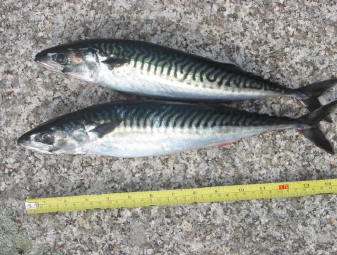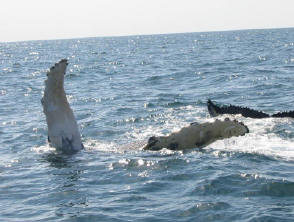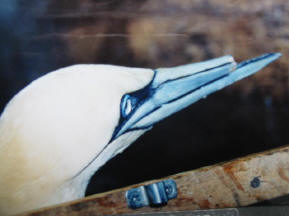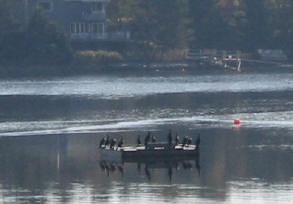|
2003: “Extraordinary” increase in herring, mackerel, and capelin numbers on the Eastern Scotian Shelf?! My challenge to DFO
Science…enough already, let’s debate this one!: you perceive a 400-500 fold
increase in small pelagic fish (herring/mackerel/capelin) on the Eastern Scotian Shelf
over the past 20 years…while I can see only starving groundfish, starving seabirds,
starving whales and that “The Emperor isn’t wearing any
My impression that things are just not adding up in fisheries science, and that maybe the right hand doesn’t know what the left hand is doing, was reinforced by reading DFO’s recent “Ecosystem Status Report”. The finding that seemed to be farthest removed from reality was the scientific calculation of a dramatic increase in the numbers of small pelagic fish that is thought to have occurred in our waters over the last two decades. Overwhelming evidence contradicts this conclusion, including mounting starvation of the natural predators that survive by eating the small fish in question. I very much want an opportunity to debate this point, along with other details of ‘what’s going on’ with marine life today, with the responsible government scientists. However, all of my considerable efforts to do this have been stymied. I am easily ignored, I suppose, because I am speaking out of turn: just an ordinary citizen with no formal training in marine science, a concerned member of the general public (read: the taxpayer who foots the bill for the ‘responsible’ science). My independent research into fisheries and marine science fills hundreds of pages on this website. If you would like to see the outcome of my debating with DFO Science, don’t hesitate to write to them (the director of the Bedford Institute of Oceanography is Michael Sinclair, email: SinclairM@mar.dfo-mpo.gc.ca The federal Minister of Fisheries and Oceans is Geoff Regan, email: Min@dfo-mpo.gc.ca ). Sending a letter to the editor of the Halifax Herald newspaper might not hurt the cause either (email: letters@herald.ns.ca ). But why should ordinary people care about this, and how is the general public to form an opinion on an issue such as “stocks of small pelagics?” First, people need to understand and care about this because there is a lot more than mackerel, capelin, and herring (pictured above) at stake. All fish stocks, all fisheries, all marine mammals and all fish-eating birds are potentially threatened by a decline in ocean fertility, which is the real sticking point of the debate. Second, regarding how to assess the “small pelagic fish,” the public might consider what they know personally about herring, mackerel and capelin, and think about what changes they may have noticed in the last two decades. Many will be familiar only with what they have eaten, or seen for sale at the fish markets, and perhaps what they’ve read in the news. People with longer memories can likely recall the common availability of much bigger mackerel and herring years ago, as compared to what one finds today. The smallness of fish today…is actually a big deal. What is the significance of mackerel, herring, and capelin being generally smaller today?
That these fish are smaller likely reflects one of two things: either they are younger fish, or they are fish that have found inadequate food to eat. The science tells us that fish being caught today are generally younger as compared to a couple of decades ago, “baitfish” species included. And this much seems believable. The overall life expectancy of fish in general is falling. While this might reasonably be expected in a heavily fished stock, it is not expected in a lightly-fished or a not-fished one…yet this trend is now commonly seen across the board, in all wild fish. On the Eastern Scotian shelf, the amount of “small pelagic fish” species caught by fishermen is no greater now than it was 20 years ago (in fact it is somewhat less), so, if these fish populations have increased in numbers by anything remotely near “500 fold,” one might expect to see many individual mackerel and herring living to ripe old ages today, since the relatively puny fishery can hardly be putting a dent in their numbers. Where are the big fish?
Both herring and mackerel were once known to live for about two decades, and a wide range of ages of these fish was commonly found in the fishermen’s nets. However, both herring and mackerel fisheries are now landing a large majority of fish less than 5 years old, and the numbers of bigger, older fish are shrinking fast. A loss of older fish that is unexplained by fishing should raise the question of declining ocean fertility, since it takes a more robust food base to support the energy demands of the biggest spawning fish. The bigger they get, the proportionally greater is the amount of spawn these fish are programmed to produce, and this helps to explain why a decline in their food base will predictably eliminate the oldest fish first. If they avoid natural predators and fishermen, fish will eventually reach a size where the spawning demand exceeds the food energy available to them. Old fish will then become seriously weakened by spawning, and may simply die, or will fall easy prey to a predator once easily avoided. The maximum size that fish can potentially attain, therefore, is one reflection of the richness of the food base available to them, a concept that can also be thought of as ‘ocean fertility.’ Declining maximum fish size may realistically indicate declining ocean fertility. This is why the smallness of the fish we see at the grocery store today may be an important warning sign about the failing health of the ocean in general, and why this particularly raises a red flag when it involves the not-terribly-popular, greasy “baitfish” such as mackerel and herring. How many baitfish are there in the ocean? The Newfoundland scientists who used the sonar to search for capelin made these notes: "Capelin in the offshore were primarily found in carpet-like layers near bottom in waters 150-400 m deep, with little or no vertical migration observed...(in contrast with, nearer shore)...Capelin in Trinity Bay...were generally off-bottom and exhibited a greater range of vertical movement than their offshore counterparts...reminiscent of those seen offshore during the mid and late 1980s" (Source: DFO. SSR B2-02 (2001))
Movements of marine animals are often dictated simply by food availability. This is true of both the baitfish themselves, and of their natural predators. The abandonment of the offshore water column by the capelin coincides with a dilution of their small zooplankton prey in that water. It seems possible, therefore, that the behavior change may have been triggered by a search for an alternate food source, and that capelin in the “carpet-like layer” may now be subsisting on small edibles associated with the near bottom water and the bottom sediment. It also seems likely, due to their greatly diminished numbers, that this alternate food source is less capable of sustaining large numbers of capelin than was the richer zooplankton supply formerly available to them. The persistence of capelin moving upward in the water column inside Trinity Bay probably reflects a greater number of zooplankton prey in this inshore location, as compared to the offshore, and this greater plankton production is likely sustained by nutrients that enter the sea via terrestrial runoff. The last remaining concentration of northern cod is also found in Trinity Bay. Therefore, a small reminder of the cod-capelin-zooplankton picture that vanished from the offshore still persists inshore. Unfortunately, not only did the scientists who assessed the Eastern Scotian shelf ecosystem neglect to do sonar surveys, but they also did not include any nearshore indicators. One wonders if they might similarly have found small pelagic fish extending up into the water column only in areas closer to shore, or inside coastal bays, with only a substantially diminished “carpet-like” layer of these fish covering the offshore bottom. After all, other major elements of the Newfoundland and Nova Scotian stories are identical. This includes the trajectories followed by both cod and plankton. While the public may possibly be aware of the presence of small pelagic fish close to shore – mackerel fishing from wharves and small boats, after all, is still doable – it is less likely that many have a sense of how abundant these fish might be offshore. Consider the behavior of the offshore baitfish predators: fishermen, fish, marine mammals and seabirds. The strongest impression is that those who hunt the baitfish all seem to be crowding closer to the shoreline now, seeming to suggest that offshore fishing for these species may no longer be profitable. Recent news headlines in Atlantic Canada have included this one: “Fishermen blockade P.E.I. wharf in herring protest.” At the heart of this conflict is the fact that large herring seiners (fishing boats that encircle schools of fish with large nets) from New Brunswick have been moving and fishing ever closer to the coast of Prince Edward Island. This problem is a new one in Atlantic Canada, fishermen fighting over herring…and it seems a strange and unlikely development to occur in the same part of the world where the numbers of herring in the sea are thought to have skyrocketed. Along the inshore edge of the Scotian Shelf, lobster fishermen who have traditionally set gillnets, easily catching all of the “baitfish” they needed for their lobster traps, now find such a scarcity of baitfish that they must buy bait from elsewhere. And in southwest Nova Scotia, so the grapevine tells me, the fleet of herring seiners is finding herring harder to locate and capture, and of a generally smaller size than in years past. These snapshots of reality seem to clash with the official scientific herring assessment.
Sightings of whales and seals close to shore have increased noticeably in recent years along the Atlantic coast of Nova Scotia, this to the great delight of coastal residents, visitors, and the whale watching industry. Close encounters between whales and people in small boats are exhilarating, and increasingly common. For myself, I have been terrified by a large black whale bursting out of the water in pursuit of a school of sand lance mere yards from my sea kayak and the beach edge that I had been meandering along. Fantastic, really, but the old-timers don’t tell stories of seeing such behavior in whales. Does their new physical proximity to our territory reflect a new food limitation and desperation in the feeding behavior of whales? Whales and herring seiners both can be seen to be moving nearer to the shore, and to be making similar adjustments to the new reality – the poverty of baitfishes - in the open sea. Whales in serious physical distress will most often escape our notice, but sometimes they come ashore to die. Consider the following incident, which occurred at P.E.I. in late 1999 (well after the purported baitfish population expansion): A severely emaciated young male fin whale, 10.5 m-long, was discovered stranded on shore. Veterinarians euthanized the whale and performed a post-mortem exam. From the whale’s size, they determined that it was just at weaning age. No abnormalities or signs of disease were noted, and their conclusion: “Therefore the most likely explanation for its severe emaciation is that it had been separated from its mother, probably several weeks earlier, had been unable to fend for itself, and had gradually starved.” (story online at: http://wildlife.usask.ca/english/backNewsLetters/NewVol7No1.htm#finwhale ) What can or should one conclude from a story like this? A healthy young whale is weaned and then starves. Everyone knows that starvation is only part of what normally occurs in nature, but...was this incident within normal, or does it contain a warning about the level of scarcity of baitfish? Actually, my ongoing survey of news concerning marine life worldwide indicates many reports of various species of starved whales coming ashore here are there, as singles and in groups. It seems to be another broad rising indicator. Are we failing to read the signs?
Much effort has been expended in trying to calculate the quantity of fish eaten by the “expanding grey seal population,” but scientists do allow that even the highest estimates of fish eaten by today’s larger seal populations do not match the amount that is now NOT being eaten by the large fish that once shared the ocean with the seals. This suggests that even with more seals in the water there should be a substantial amount of small fish ‘leftovers’ because the large fish are no longer there to eat their share. It then becomes hard to understand how the harbour seals failed to find enough fish to eat. Even if the grey seal population has increased by a factor of 10 over the last 2 decades (the highest estimate considered), the small pelagic fish have supposedly greatly outpaced this, increasing by a factor of 500. So, why no fish for the Sable Island harbour seals? Somehow, this story just doesn’t add up.
Fish-eating seabirds are useful baitfish-indicators with which the public may have some familiarity. Diving underwater, using wings as efficiently as flippers, specialized seabirds like puffins, cormorants and gannets are fast swimmers that pursue small pelagic fish and snatch them from the water column. Surfacing with a small silver fish in its beak, the bird gives its head a quick shake and promptly swallows the fish whole. Should the baitfish congregate only at the very bottom, however, as in the “carpet-like layer” at Newfoundland, fishing will predictably become a greater challenge for these birds. And indeed, increasing starvation of puffins and murres has been reported at Newfoundland in recent years. Analyses of these birds’ stomach contents have shown a dietary shift away from the rich, oily baitfish toward less nutritious small crustaceans.
Fellow Canadian taxpayers, I find it incredible that the scientists we are paying to “conserve and protect” marine life are failing to assess these not-so-subtle changes, or to address these questions, including the fundamental question of ocean fertility. If it were not so tragic, I might say that their miscount of the small pelagic fish off Nova Scotia was laughable. My questions to DFO have been rebuffed consistently whenever I have touched on the really serious points (e.g. ocean fertility assessment), and they have made it perfectly clear that they feel they are not answerable to me. Is this right? To whom might these public employees be answerable? Will it take the sudden mass mortality of everyone’s favorite whales to awaken DFO to the reality of what is happening in the coastal ocean? Or would such an incident even jar the status quo at DFO Science? (Whales will become increasingly threatened by both starvation and marine toxins as ocean fertility falls; this much is predictable. How soon this might occur is less certain, but over 20 whales died this summer in waters just south of here from domoic acid poisoning, in an event unlike any recorded in this area before.) My suggestion: that we take the $80 million recently earmarked for improvements at the Bedford Institute of Oceanography and the $6 million designated for new “seal research” and instead fund an urgent independent inquiry into why marine science is such a dismal failure, why our world class ocean science still cannot explain the reason cod and other fish are starving, and how it could possibly err on the scale of the recent ridiculous baitfish estimation. “Doctors would be sued for malpractice if they diagnosed patients the way many scientists are diagnosing oceans.” - Jeremy Jackson, Scripps Institution of Oceanography |
 November
16, 2003. In response to a recent news story, "
November
16, 2003. In response to a recent news story, "

 Many
clues are offered by the natural predators of small pelagic fish.
These predators include larger fish, such as adult groundfish, along with
a variety of seabirds, seals and whales. And increasingly, all of these
predators can be seen to be concentrated closer to the shorelines than
they were in the past. Some clues have been noted in scientific
assessments, such as the increasing tendency of humpback whales to be
found inshore at Newfoundland and the consequent greater frequency of
their becoming entangled in fishing gear. Humpback whales (calf pictured
at left), along with other fish-eating baleen whales like minkes and fin
whales, consume small pelagic prey by taking great gulps of water and
filtering out the fish. This would seem to be rather more difficult should
the prey only exist as a “carpet-like layer” on bottom. If this in fact
should now characterize the offshore distribution of baitfish such as
capelin, more nearshore whale sightings would be a logical consequence,
and this does seem to agree with the recent personal experiences of many
people.
Many
clues are offered by the natural predators of small pelagic fish.
These predators include larger fish, such as adult groundfish, along with
a variety of seabirds, seals and whales. And increasingly, all of these
predators can be seen to be concentrated closer to the shorelines than
they were in the past. Some clues have been noted in scientific
assessments, such as the increasing tendency of humpback whales to be
found inshore at Newfoundland and the consequent greater frequency of
their becoming entangled in fishing gear. Humpback whales (calf pictured
at left), along with other fish-eating baleen whales like minkes and fin
whales, consume small pelagic prey by taking great gulps of water and
filtering out the fish. This would seem to be rather more difficult should
the prey only exist as a “carpet-like layer” on bottom. If this in fact
should now characterize the offshore distribution of baitfish such as
capelin, more nearshore whale sightings would be a logical consequence,
and this does seem to agree with the recent personal experiences of many
people. 
 Along
the coast of Nova Scotia in recent years, cormorants have moved ever
closer to the shoreline. Once well known only to the fishermen when they
fished outside of the coastal inlets, dark, double-crested cormorants are
now a common sight to anyone living near the coastline. They can be seen
fishing inside all of the shallow inlets, perched on docks and moorings
where they were never seen before. Many times now, if you watch, you will
see that the cormorants are catching small crabs rather than fish. The
bird surfaces, in its beak a small flailing crab held by one leg. The bird
gives its head a quick shake…and the crab flies off and sinks, while the
bird swallows the detached crab leg. Another dive ensues, as the bird must
catch the crab repeatedly in order to eat it in pieces. One can easily
appreciate that if crabs are the only prey now available to a bird such as
the cormorant, that it will fish in as shallow an area as possible in
order to save the energy needed for deep diving. It also seems certain
that the crab, along with being a less rich food than fish, is a
relatively awkward prey for this bird and is therefore not a preferred
food. This changed behavior, easily observed now in seabirds, speaks
volumes about the abundance of small pelagic fish in Nova Scotia’s coastal
waters. Not relying on outmoded methods of calculating baitfish numbers,
but telling the truth about its current feeding options, the cormorant
seems to offer testimony in direct contradiction to that of the experts at
DFO.
Along
the coast of Nova Scotia in recent years, cormorants have moved ever
closer to the shoreline. Once well known only to the fishermen when they
fished outside of the coastal inlets, dark, double-crested cormorants are
now a common sight to anyone living near the coastline. They can be seen
fishing inside all of the shallow inlets, perched on docks and moorings
where they were never seen before. Many times now, if you watch, you will
see that the cormorants are catching small crabs rather than fish. The
bird surfaces, in its beak a small flailing crab held by one leg. The bird
gives its head a quick shake…and the crab flies off and sinks, while the
bird swallows the detached crab leg. Another dive ensues, as the bird must
catch the crab repeatedly in order to eat it in pieces. One can easily
appreciate that if crabs are the only prey now available to a bird such as
the cormorant, that it will fish in as shallow an area as possible in
order to save the energy needed for deep diving. It also seems certain
that the crab, along with being a less rich food than fish, is a
relatively awkward prey for this bird and is therefore not a preferred
food. This changed behavior, easily observed now in seabirds, speaks
volumes about the abundance of small pelagic fish in Nova Scotia’s coastal
waters. Not relying on outmoded methods of calculating baitfish numbers,
but telling the truth about its current feeding options, the cormorant
seems to offer testimony in direct contradiction to that of the experts at
DFO.